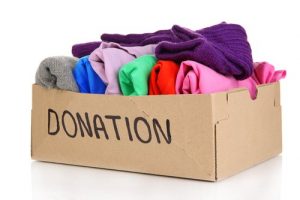In the age of social media fashionistas and beauty gurus, it’s easy to get caught up in the thrill of the hunt for the latest rags. Last year’s outfits linger on in the dark side of the closet until they form a looming pile of fashion faux pas eating up all your free space.
This all leads to the cliched scene of people standing in front of a mountain of “so-last-season” outfits and mismatched accessories, proclaiming, once again, that they don’t have anything to wear. Sound familiar?
Well, modern fashion is a fickle mistress, and her moods keep changing all the time, with new trends replacing old ones within a few months. So, what does one do with all that perfectly functional, yet tragically outdated or no longer fitting clothes?
Believe it or not, donating clothes not only helps bring a smile to someone’s face, but it’s actually great for the environment. Here are a few more details on why that is, and how you can contribute.
The Fast Fashion Crisis
 The global clothing production has nearly doubled in the last 15 years thanks to the growing middle class and bigger purchasing power.
The global clothing production has nearly doubled in the last 15 years thanks to the growing middle class and bigger purchasing power.
While a strong middle class is essential for a healthy economy, it’s brought along certain problems with it.
The fashion industry has taken advantage of the bigger purchasing power and pushed forward the trend of fast fashion.
This means that the consumers are constantly forced to discard of their barely used clothes, since they quickly go out of style, and keep on buying new products.
The problem with this is that the fashion industry is notoriously wasteful and has a detrimental effect on the environment. This is why it’s crucial for us as the consumers to let go of the fast fashion and take an active part in creating a sustainable circular economy.
Clothing Donation Reduces Landfills
 If more consumers opted to reuse or repurpose their clothes or donate them so that they can start their second life someplace else, it could have a very positive effect on the environment.
If more consumers opted to reuse or repurpose their clothes or donate them so that they can start their second life someplace else, it could have a very positive effect on the environment.
One of the bigger problems that the world is facing today is textile-waste. Compared to the year 2000, the average consumer today buys 60% more items of clothing but keeps those items for half as long.
Seeing how only a small percentage of clothing is donated or recycled, most of these textiles are taken to the landfills.
The problem here is that landfills aren’t only destroying the aesthetic appeal of a neighborhood, they add to our pollution levels.
Decomposing textiles emit toxins that are released into the air and water and are polluting our environment. The bigger our landfills, the higher the levels of pollution.
Clothing Donation Saves Water
 The meaning here is twofold. Primarily, when you donate clothes and they’re reused by someone else, there’s no need for such high production of new items since there would be no one to buy them.
The meaning here is twofold. Primarily, when you donate clothes and they’re reused by someone else, there’s no need for such high production of new items since there would be no one to buy them.
Now, to produce new clothes, the fashion industry uses inordinate amounts of water. Take for example cotton, it is a popular material used in textile production, and it’s a plant that’s highly water intensive.
Secondly, clothing donation saves water by protecting it from polluting chemicals. Think back to the huge landfills and the toxins released by textiles. When the rain falls on those landfills, the water rinses out the chemicals, and together they accumulate at the base of the landfill, eventually finding their way down to the groundwater.
On the other hand, we have clothes made of synthetic materials, namely nylon. Not only does the production of nylon involve great greenhouse gas emissions, but nylon breaks down in the washing machines and causes a buildup of microplastics in our water systems.
It Helps Us Reduce Our Carbon Footprint
The more dangerous chemicals released by decomposing textiles in the landfills are carbon dioxide and methane, both very potent greenhouse gasses that add to the global warming crisis.
 The production of new clothes creates problems as well. The fashion industry is estimated to be contributing to around 10% of global greenhouse gas emissions, that’s well above the travel and tourism industries.
The production of new clothes creates problems as well. The fashion industry is estimated to be contributing to around 10% of global greenhouse gas emissions, that’s well above the travel and tourism industries.
The production of new clothes requires a lot of water and a lot of power. The more power you need, the bigger the emissions of greenhouse gases.
If the fashion industry continues in the manner of “business per usual,” and if the consumers keep buying then quickly discarding of new clothing, continuing with the fast fashion trend, gas emissions will continue to rise and our environment will continue to be polluted.
Clothing donation will ensure that all the water and energy that was used in the creation of new garments will not simply go to waste. The longer used clothing is in circulation, the fewer clothes will be produced and discarded at landfills.
You Can Help Those in Need
Donating your used clothing can help countless people. Primarily, donated clothes are often sent to third world countries to be sold at cheaper prices. This allows people living in poverty to afford much-needed clothes and shoes.
Secondly, your donations are also sent to disaster-stricken areas. Those affected by natural disasters or war have to flee from their homes and are often left with no possessions at all. You can help them by donating clothing and other items that you no longer have a need for.
Circular Economy Helps Us Build a Brighter Future
By donating used clothing, you’ll be contributing to the circular economy where things are manufactured, used for as long as possible, then recycled. The circular economy would help us build a sustainable environment where things don’t go to waste as easily, and where everything is being used to its maximum potential.
So as far as your used clothing goes, if you’re not using it, put it back into circulation. Your clothing donation will help you do something good for the environment, for others, and in the end, for yourself.
Contact us today to find out more about Bank & Vogue’s role in the Circular Economy. We work with charities, thrift stores, sellers and buyers worldwide, facilitating the sale and purchase of bulk used clothing and other used goods.







